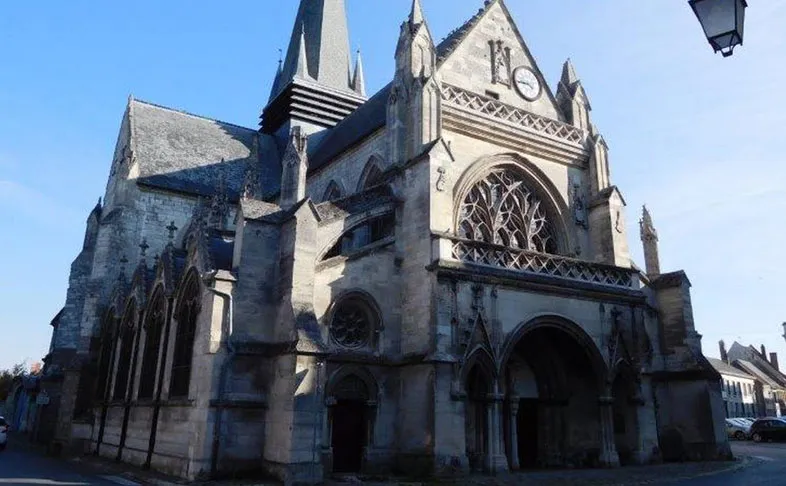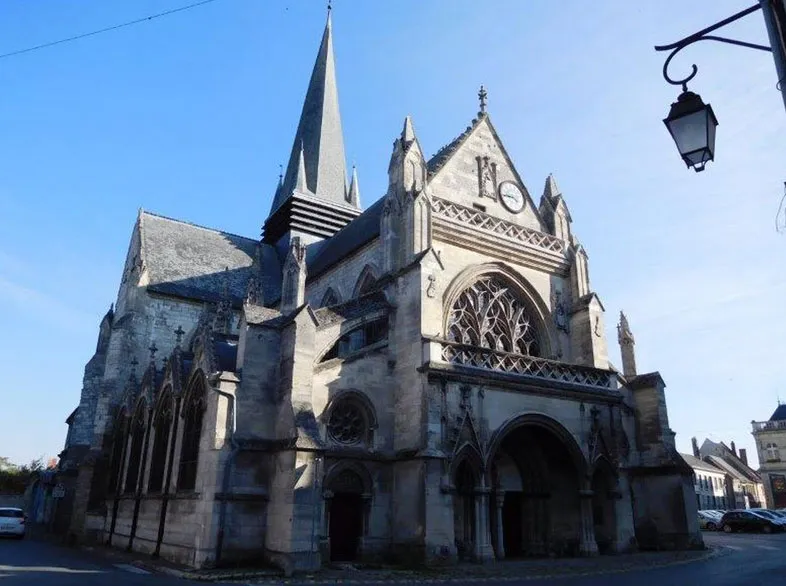
Introduction
The Basilica of Notre-Dame de Liesse, France / Liesse-Notre-Dame (French pronunciation: [ljɛs nɔtʁ dam]) is a commune in the Aisne department in Hauts-de-France in northern France. In the Middle Ages, the village near Laon developed around the cult of the Black Virgin, known as Notre-Dame de Liesse (Our Lady of Joy/or Jubilation). Pope Pius IX granted the Marian image a decree of canonical coronation on 18 August 1857.
The Basilica of Notre-Dame de Liesse, France is a place of worship steeped in history, from the year 1134 when Notre-Dame miraculously freed 3 brothers from this countryside, to the present day. It was and still is the place of strong spiritual experiences as evidenced by the multitude and diversity of the objects present.
This page dedicated to the basilica presents the outline of the historical heritage of this monument. To find out more, the reader can consult the works that have been devoted to him.
The Basilica of Notre-Dame de Liesse, France was built on the site of a chapel built by the three brothers miraculously freed by the Virgin Mary in 1134 while they were prisoners. The story says that when they returned home en route to Marchais (located 4 kilometers away), the statue of the Virgin became too heavy there. They understand that the Blessed Virgin thus manifests her wish that the miraculous statue be installed in this place.
The Basilica of Notre-Dame de Liesse, France, in the Flamboyant Gothic style, was built later in 1344 and enlarged in 1480, as evidenced by a stone engraved under the porch.
In the 19th century, the building was then enlarged by side doors: the south aisle (1873) and the north aisle (1884).
In 1913, Pius X granted the church the title of Minor Basilica , an honorary title linked to the influence of the Liesse pilgrimage.
The Basilica of Notre-Dame de Liesse, Francewas listed as a Historic Monument in 1920.
History of Basilica of Notre-Dame de Liesse, France
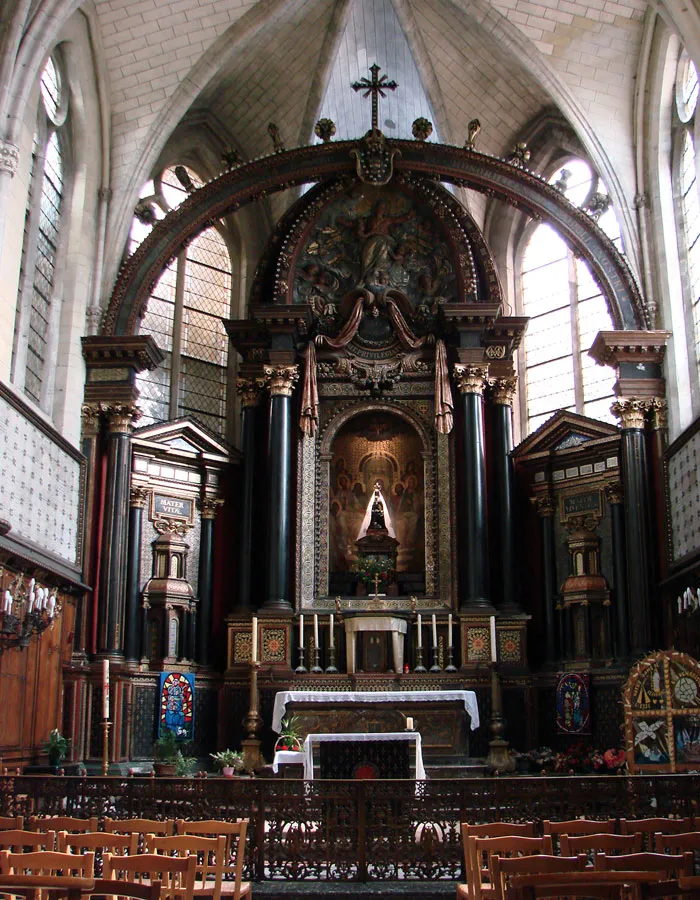
Ever since the twelfth century Liesse Notre Dame (Our Lady of Joy) has been a center of Marian pilgrimage.
The Basilica of Notre-Dame de Liesse, France was built during the late thirteenth and early fourteenth centuries and probably replaced an earlier chapel. According to ancient documents, the first shrine of Liesse was built by the pious Bartholomew of Vir, with the stones left over from the construction of Laon Cathedral.
The portal and façade were constructed in the fifteenth century by Bishop of Laon, Charles of Luxembourg (1473-1519), son of the Count of Saint Pol, Constable of France under Louis XI. Formerly one of the portal stones were engraved with the inscription: As a monument of their piety and their gratitude to the Virgin Mary, this holy temple was built in 1134 by the knights of Eppes. It was rebuilt in 1384 and enlarged in 1480.”
In November 1568, the troops of the Protestant Prince of Orange looted the village and its church, and having broken the statues and removed the bells, set fire to the church, reducing the bell tower to ashes. Restoration commenced nine years later.
At a young age, Madame Acarie was brought to Liesse in 1572 by her parents and consecrated to Our Lady, as was the child Henri Boudon. It was a favorite shrine of Princess Henrietta Maria of France. Jean-Jacques Olier visited in 1632. In 1686, after Trinity Sunday, 1686, after Jean-Baptiste de La Salle and the Brothers took their first vows, they made a pilgrimage to Liesse, walking all through the night, and again pronounced the vows before at the statue of Our Lady of Joy above the main altar). The church is now a minor basilica. Benedict Labre made a pilgrimage to Liesse in 1770.
Prior to the Revolution, pilgrimages supported the economy of the village. There were a number of hostelries to provide accommodations for pilgrims. The manufacture and sale of religious souvenirs were a dominant activity. Destroyed during the revolution, the shrine was later rebuilt.
Architecture of Basilica of Notre-Dame de Liesse, France
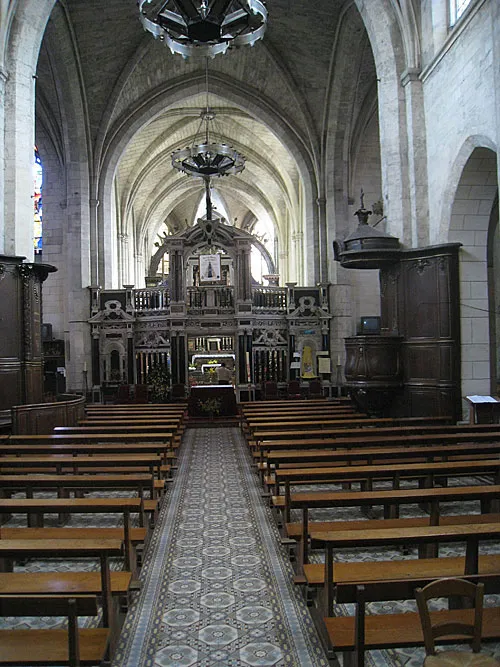
Liesse was a favorite destination for royal pilgrimages, visited by Louis VII, Charles VI, Charles VII and others. Devotion to Our Lady of Joy spread throughout France, particularly to Normandy where there are a number of churches dedicated to Mary under this title. An annual pilgrimage used to be held in Aude in Fleury sanctuary refounded in the seventeenth century by an archbishop of Narbonne named Louis Vervins. Our Lady of Liesse is also honored in Belgium, Canada, and Malta. Jesuits spread the devotion to Africa.
Basilica of Notre-Dame de Liesse, France is the patroness of the Diocese of Soissons.
The present site contains a pilgrim shelter that is intended primarily to accommodate pilgrims and gatherings of parishes in the diocese of Soissons, but it is open also to families and associations.
Our Lady of Liesse
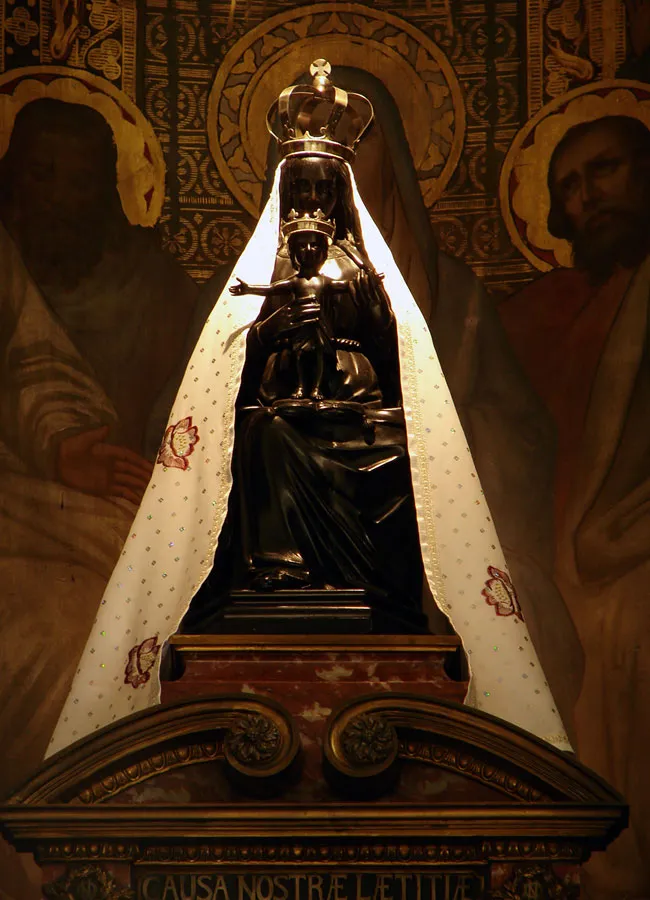
The pilgrimage to Our Lady of Liesse, in Picardy, not so old as those of the south of France, as it does not go farther back than the twelfth century, surpasses them in celebrity. The origin of the statue of the Blessed Virgin, which adorns this holy place, is very marvelous; the tradition has been preserved, not only in the province of France where it is found, but also in the Holy Land. We are even assured that it exists in the archives of the Knights of Malta. Here is the tradition, which bears a very decided oriental stamp.
Foulques of Anjou, King of Jerusalem, having rebuilt the fortress of Bersabee, four leagues from Ascalon, to protect the frontier of his kingdom against the incursions of the Saracens, confided the care of it to the brave and pious knights of Saint John of Jerusalem. This valiant garrison was often engaged against the infidels who held the ancient country of the Philistines for the Sultan of Egypt.
One day the knights of Saint John, among whom were three brothers of the ancient and opulent house of Eppes, in Picardy, fell into an ambush, and in spite of prodigies of valor, were taken and laden with chains by the Muslims, who sent them into Egypt. The gentlemen of Eppes had the lofty mien, the tall stature, and the heroic bearing of the ancient nobles of the north of France.
The sultan at once singled them out, and, desirous of gaining them over to his false prophet, began by throwing them into a dungeon to weaken their courage. He held before their eyes afterwards the most enticing prospects, in order to draw them into apostasy.
The three warriors, who had been inaccessible to fear, were deaf to the noise of gold and the voice of ambition. The sultan, deceived in his expectations, sent to them the most celebrated imams, to argue with them upon faith. The good knights, through disgust of Islam, became all at once subtle theologians, and defended Christianity as well in dispute as they had often done with the shield on their arm and the lance in their grasp.
The sultan considered himself bound in honor to vanquish the captives, and his opposition increased with their resistance. He swore that the Knights of Saint John should follow the standard of the prophet, even if it should cost him the half of Egypt.
He had a daughter handsome, chaste, accomplished, and every way worthy to follow a better faith; he sent her to the dungeon where the French knights were languishing in fetters, and charged her to set before them a frightful picture of the punishments prepared for them.
The knights received the princess with those testimonies of respect which were at that time lavished upon ladies; but they repelled her insinuations with the resolute courage of men who accept of martyrdom, and explained to her their belief in a manner so persuasive that the Muslim lady betook herself to serious reflection on Christ and His Blessed Mother.
History of Our Lady of Liesse
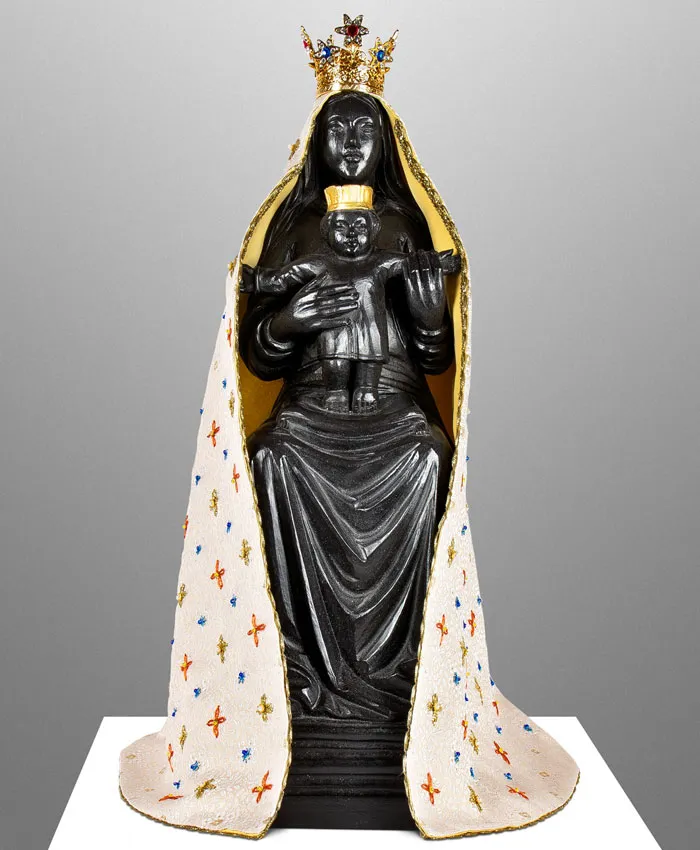
A miraculous and resplendent image of Mary, Our Lady of Liesse, which, it is said, was brought by angels to the pious champions of the Christian faith, completed the conversion of the young infidel. One night, when she had gained over the guards of the three French warriors by bribes of gold, she made her way into their prison with a casket full of precious stones, and made her escape with them from her father’s palace.
After passing the Nile in a boat prepared for their reception, the fugitives directed their course towards Alexandria, hoping, perhaps, to conceal themselves for a time in the Coptic monasteries of the desert of Saint Macarius.
But, after marching for some hours, the princess, exhausted with fatigue, wished to rest for a little while, and, in spite of the imminent danger, the three knights of Saint John, determined to keep good guard, made her sit down in a field of doura in full verdure, and seated themselves at a respectful distance. The princess fell asleep, and her travelling companions, after struggling in vain against the drowsiness which followed long nights without rest, slept soundly also.
No one knows how long their slumber continued. The knight of Eppes, the eldest of the three, was the first who awoke; the sun was beginning to gild the tops of the trees, where he heard the sweet singing of birds. The crusader looked at the landscape with great surprise: he had gone to sleep in sight of the Nile and the pyramids, under the fan-like branches of a palm-tree, and he awoke beneath an oak, with knotty branches, on the margin of a clear spring, on the freshest turf, sprinkled with white daisies.
A short distance off, the round and dark towers of an old baronial castle reminded him of the manor where he had left his mother, all in tears at his departure for the Holy Land. A shepherd, who was driving his sheep to the fields, relieved him of his perplexity; the castle which he beheld was in fact his own castle of Marchais, and he awoke in Picardy, beneath the avenue which his fathers had planted. He blessed the Holy Virgin, and awakened his companions, whose astonishment was as great as his own.
They had preserved the image of the oriental Madonna; they built a handsome church to receive Our Lady of Liesse, and the Muslim princess received baptism in the cathedral of Leon. We may innocently believe that this little statue of Mary came into France by more natural means; but what it is impossible to doubt is, that it was brought from the Holy Land by three great men of Eppes, knights of Saint John of Jerusalem.
The most illustrious names of the monarchy figure in the list of pilgrims to Our Lady of Liesse. We read there those of the Duke of Burgundy, Louis II of Bourbon, Prince of Conde, Duke of Mercoeur, of Prince Albert Hermy of Ligne, of Madam Henrietta Frances of France, Queen of England, of the princes of Longueville, of Marshal D’Ancre, of Mademoiselle de Guise, of the Count D’Egmont, of Louis, Duke of Orleans, brother of Charles VI, of Charles VII, of King Rene, Of Louis XI, of Francis I, of Henry II, of Charles IX, of Queen Mary of Medicis, of Louis XIII, of Ann of Austria, of Louis XIV.
Several of these great personages, not satisfied with leaving rich presents to Our Lady of Liesse, placed their statues there: that of Louis II of Bourbon, Prince of Conde, was of gold. Mary D’Arquin, then grand Marshal of Poland, and who was afterwards queen of that kingdom, came to the chapel of Our Lady in 1671; she offered to the Blessed Virgin a child in silver, representing the Prince Alexander Sobieski, her son, with a golden chain enriched with diamonds, to testify that she devoted him to the Mother of God, as her slave.
This sanctuary was pillaged like the others by the Protestants; the Revolution came to glean whatever was left.
The chapel of Our Lady of Liesse still attracts, at the present day, a great concourse of pilgrims.
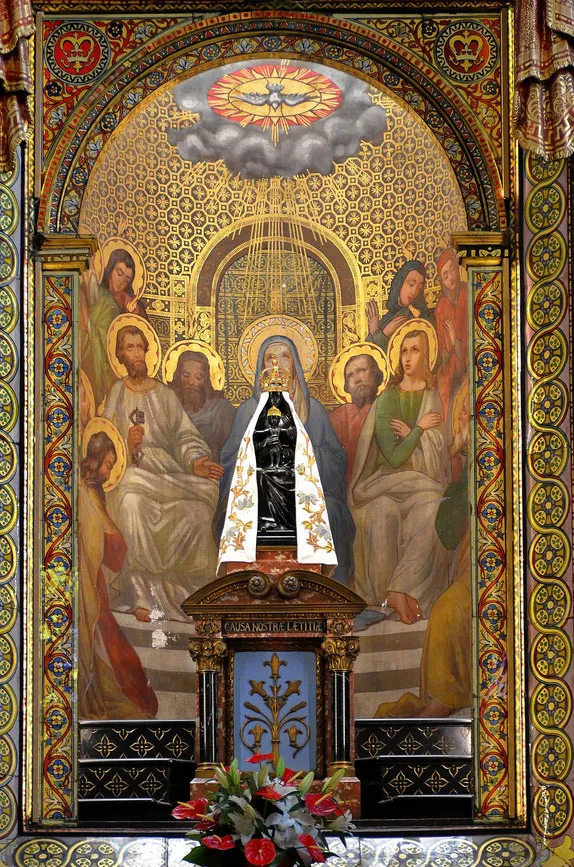
Legends
The statue is said to have been brought to Liesse by three Knights Hospitaller. The three were brothers and members of the noble house of Eppes in Picardya. Sometime in the twelfth century, while protecting the fortress of Bersabee, near Ascalon, they were captured in a Saracene ambush and taken to the Sultan of Egypt.
The knights refused to convert to Islam, despite theological arguments and promises of gold and honor. Angels brought the three imprisoned knights a small statue of Our Lady for consolation. The Sultan decided to send his daughter Ismeria to the dungeon to convert the three knights. But the knights preferred to talk about what unites people of different religions. She learns about the Christian god and is prompted to assist in the brothers’ escape.
During their flight all four fall asleep, and during their sleep are miraculously transported to Northern France. Awakening close to the Eppes’ castle in Picardy, their joy and that of their family is immense. Ismeria receives baptism in the cathedral of Laon. The knights preserved the statue of the Madonna, and built a handsome church to receive Our Lady of Liesse. According to a sixteenth century tradition, the knights were the sons of William, sire of Eppes. Their names were Jean, Hector, and Henri.
A second story recounts how in 1139 a thief had recourse to Notre-Dame de Liesse and she saved him from hanging.
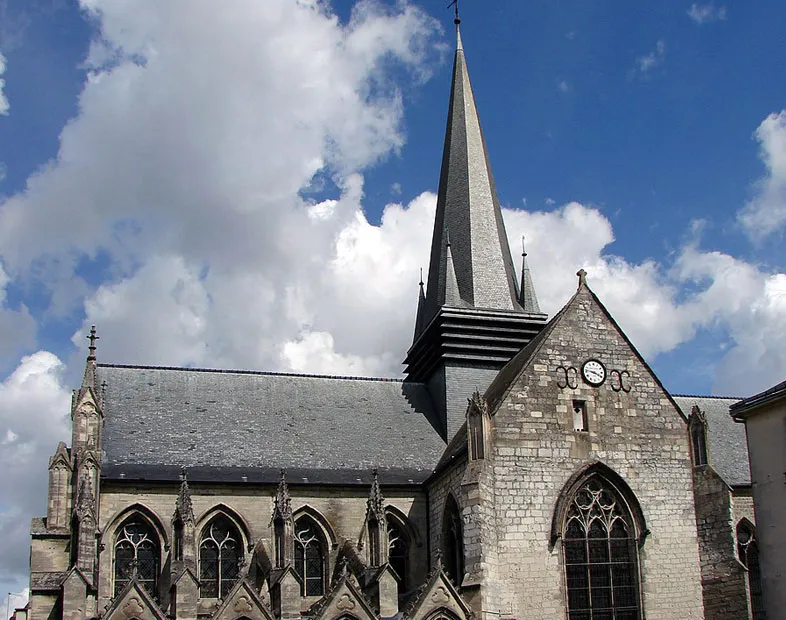
Grand Marais
The Grand Marais consists of about twenty hectares of marshland with mainly bog ponds, wet wood and reed beds.In the eighteenth century, the march was mainly used for grazing and for cutting peat for heating. The Great Swamp is home to over 232 species of plants, birds and dragonflies native to Picardy. The local municipal council works with the Conservatory of Natural Sites of Picardie to preserve the site.
The Choir
The choir was built in the 14th century.
In the 17th century, 2 new elements were added: the high altar to receive the statue of the Black Virgin and the rood screen to isolate the choir and the sanctuary from the nave.
The statue of the Black Madonna is placed on the tabernacle in the high altar . The latter is in the Italian Renaissance style and was offered in 1610 by Marie de Médicis, wife of Henri IV, and a native of Florence, at the birth of Louis XIII. It was recently restored by the Order of Malta. Behind the statue is a fresco representing Pentecost: the Holy Spirit descends on the Apostles while Mary is with them.
At the top of the building, a bas-relief represents the Assumption : Mary ascended in glory, with her body, close to God.
The woodwork and the communion bench were made around 1780, when Abbé Dantheny was at the Basilica. This priest was guillotined in Laon at the end of December 1795. His last look was for Liesse after having kissed his executioner as a sign of forgiveness.
The black and white marble rood screen was donated in 1616 by Marie de Gonzague (Guise-Lorraine family). From this monument, the Epistle and the Gospel were once proclaimed.
Its wrought iron gate was donated by the Soyecourt family.
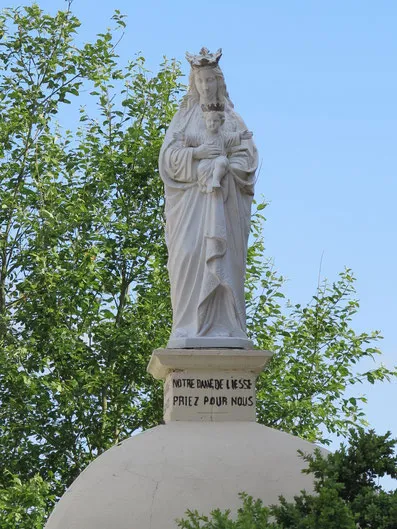
The Miraculous Fountain
According to the story of Notre-Dame de Liesse, the three knight brothers and Princess Ismérie woke up on July 2, 1134 at the edge of a fountain after being miraculously transported from Cairo to this place. They then go to find their relatives in the village of Marchais 3 km away. Realizing that they have forgotten the statue, they retrace their steps. They then discover that the fountain has overflowed and the miraculous statue is partly submerged in water.
This water has brought about many healings. Melchior Bandini, analyst of the Order of Malta noted this in 1446.
An ancient chapel served for a long time as an oratory in this place. It was replaced in 1857 by the current chapel, built on the plan of Santa Casa de Lorette.
The Well
At the origin of the pilgrimage, the marshes were much higher. At this place, the water came out through an artesian well. This is what makes it possible to understand that the statue “fell into the water” since the water was then at ground level.
The “fountain” is now a well since the level of the marshes was lowered by the cleaning and the channeling of the Souche which drains the marshes to Crécy sur Serre.
For a long time, people staying at the retirement home ensured the drawing of water that they made available to pilgrims, in exchange for a little song and a few coins.
The aedicule that covers the well, intended both to guarantee its safety and to adorn it, has undergone various transformations throughout history. It was renovated in 2017. On June 2, 2017, Monseigneur de Dinechin, Bishop of Soissons, blessed the renovated fountain.
The Stained Glass Windows
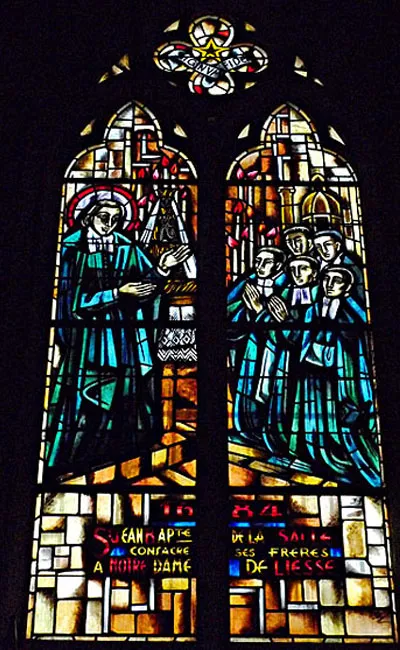
The contemporary stained glass windows of the Notre-Dame de Liesse basilica, totally recreated (after the bombardment of May 1940 and the battles of the Second World War) by Jacques Despierre (French artist, member of the Institut de France and of the Académie des Fine Arts) date from 1976 . They are the fruit of 7 years of thought and work.
The recounted episodes celebrate the Virgin, Holy History, the faith of the people of France and their close ties with the great religious and monastic orders that participated in the influence of Notre-Dame de Liesse.
Their evocative and semi-figurative style, in a unity of blue-yellow-red tones, deserves our time to contemplate them.
So let’s enter the basilica for a tour, let’s look at these stained glass windows.
On the left, the 4 chapels on the north aisle reveal the stained glass windows that contribute to their history.
Feast Day - 2nd December
Annual Feast Day of Our Lady of Liesse, Cause of Our Joy held on 2nd December.
Mass Time
Weekdays
Saturdays
Sundays
Church Visiting Time
- Winter – Mondays, Thursdays, Saturdays & Sundays : 2:00 pm to 5:00 pm
- Summer – Every Days : 2:00 pm to 6:00 pm
Contact Info
Pl. du Parvis, 02350,
Liesse-Notre-Dame, France.
Phone No.
Tel : +33 3 23 22 20 21
Accommodations
How to reach the Basilica
Laon – Chambry Airport at Rue de Crécy Aviation, Laon, France is the nearby airport to the Basilica.
Coucy-lès-Eppes Railway Station located in Coucy-lès-Eppes, Aisne, northern France is the nearby Train Station to the Basilica.

